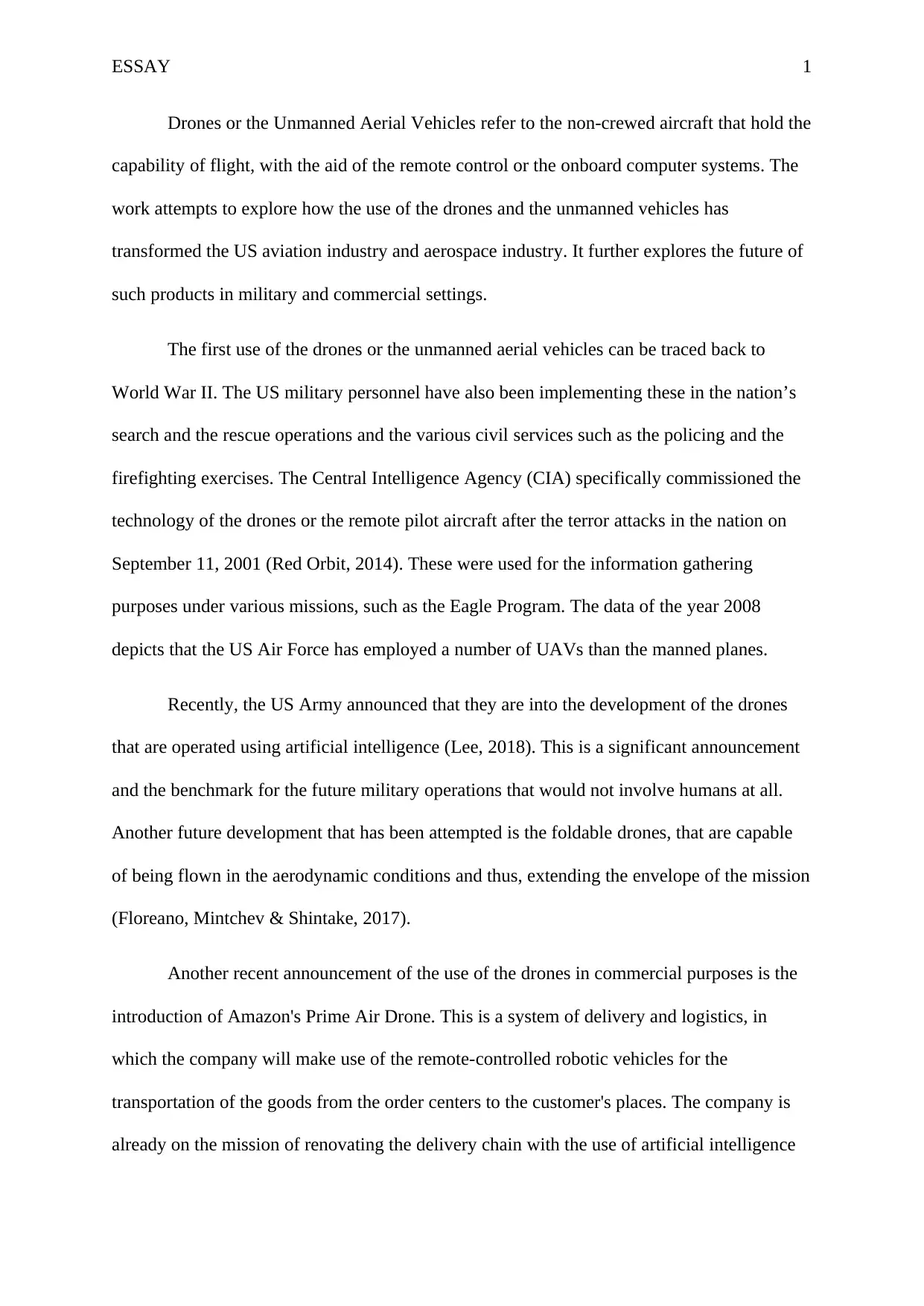Essay on Drones and the Future Impact on US Aviation and Aerospace
VerifiedAdded on 2023/05/30
|5
|988
|222
Essay
AI Summary
This essay delves into the significant impact of drones, or Unmanned Aerial Vehicles (UAVs), on the US aviation and aerospace industries. Tracing their origins to World War II and their subsequent adoption by the US military and civil services, the essay highlights the evolution of drone technology, including the use of artificial intelligence in military operations and the development of foldable drones. Furthermore, it examines the commercial applications of drones, such as Amazon's Prime Air delivery system, emphasizing their potential to transform logistics and supply chains. The essay also addresses the various fields where drone technology is being employed, from agriculture to media, and acknowledges the challenges surrounding safety, security, regulations, and privacy. Finally, it concludes that drones are a vital innovation, while stressing the need for detailed regulations to ensure their efficient and responsible utilization.

28 November 2018
Drones and the future of aviation
Drones and the future of aviation
Paraphrase This Document
Need a fresh take? Get an instant paraphrase of this document with our AI Paraphraser

ESSAY 1
Drones or the Unmanned Aerial Vehicles refer to the non-crewed aircraft that hold the
capability of flight, with the aid of the remote control or the onboard computer systems. The
work attempts to explore how the use of the drones and the unmanned vehicles has
transformed the US aviation industry and aerospace industry. It further explores the future of
such products in military and commercial settings.
The first use of the drones or the unmanned aerial vehicles can be traced back to
World War II. The US military personnel have also been implementing these in the nation’s
search and the rescue operations and the various civil services such as the policing and the
firefighting exercises. The Central Intelligence Agency (CIA) specifically commissioned the
technology of the drones or the remote pilot aircraft after the terror attacks in the nation on
September 11, 2001 (Red Orbit, 2014). These were used for the information gathering
purposes under various missions, such as the Eagle Program. The data of the year 2008
depicts that the US Air Force has employed a number of UAVs than the manned planes.
Recently, the US Army announced that they are into the development of the drones
that are operated using artificial intelligence (Lee, 2018). This is a significant announcement
and the benchmark for the future military operations that would not involve humans at all.
Another future development that has been attempted is the foldable drones, that are capable
of being flown in the aerodynamic conditions and thus, extending the envelope of the mission
(Floreano, Mintchev & Shintake, 2017).
Another recent announcement of the use of the drones in commercial purposes is the
introduction of Amazon's Prime Air Drone. This is a system of delivery and logistics, in
which the company will make use of the remote-controlled robotic vehicles for the
transportation of the goods from the order centers to the customer's places. The company is
already on the mission of renovating the delivery chain with the use of artificial intelligence
Drones or the Unmanned Aerial Vehicles refer to the non-crewed aircraft that hold the
capability of flight, with the aid of the remote control or the onboard computer systems. The
work attempts to explore how the use of the drones and the unmanned vehicles has
transformed the US aviation industry and aerospace industry. It further explores the future of
such products in military and commercial settings.
The first use of the drones or the unmanned aerial vehicles can be traced back to
World War II. The US military personnel have also been implementing these in the nation’s
search and the rescue operations and the various civil services such as the policing and the
firefighting exercises. The Central Intelligence Agency (CIA) specifically commissioned the
technology of the drones or the remote pilot aircraft after the terror attacks in the nation on
September 11, 2001 (Red Orbit, 2014). These were used for the information gathering
purposes under various missions, such as the Eagle Program. The data of the year 2008
depicts that the US Air Force has employed a number of UAVs than the manned planes.
Recently, the US Army announced that they are into the development of the drones
that are operated using artificial intelligence (Lee, 2018). This is a significant announcement
and the benchmark for the future military operations that would not involve humans at all.
Another future development that has been attempted is the foldable drones, that are capable
of being flown in the aerodynamic conditions and thus, extending the envelope of the mission
(Floreano, Mintchev & Shintake, 2017).
Another recent announcement of the use of the drones in commercial purposes is the
introduction of Amazon's Prime Air Drone. This is a system of delivery and logistics, in
which the company will make use of the remote-controlled robotic vehicles for the
transportation of the goods from the order centers to the customer's places. The company is
already on the mission of renovating the delivery chain with the use of artificial intelligence

ESSAY 2
delivery drones (Seidel, 2017). The introduction of the drones like these is regarded as the
vital step for the logistics and supply chain transformation in the future. This is because the
vehicles like these will aid in gathering, transmitting, and processing a large amount of data,
as well as the saving of the time and cost. In addition, the drones would be programmed to
gather exploitable information, which can be used to target marketing opportunities in the
industry.
Some of the other fields where the drone technology has been employed and the
industry is being benefitted are agriculture, architecture and construction, engineering,
environmental monitoring and conservation, media, training, wireless internet access,
education and much more. Thus, the scope for the future research and the developments are
wide in the above-listed fields, as well as others.
Thus, over the years, the use of the drones have extended to a number of fields, apart
from the military, such as the commercial, scientific and more. However, a number of
challenges such as the safety, security, regulatory requirements, liability, cost considerations,
privacy, and ownership have surrounded these unmanned aerial vehicles (Rao, Gopi &
Maione, 2016). These pose complex vulnerabilities as well for the future of the use of drones
in both the military and commercial purposes. As in terms of the current scenario, it can be
stated that the current guidelines as issued by the Federal Aviation Administration (FAA) are
not enough to comprehensively govern the coverage policy of such drones for the various
kinds of liabilities, damage to the property, privacy invasion, personal injury, and such. The
broad applications of the commercial uses of the drones must be regulated to ensure the
widespread acceptance and the successful adoption of these vehicles.
Thus, as per the discussions conducted in the previous parts, it can be concluded that
the drones or the unmanned aerial vehicles are a significant innovation that has proved to be
delivery drones (Seidel, 2017). The introduction of the drones like these is regarded as the
vital step for the logistics and supply chain transformation in the future. This is because the
vehicles like these will aid in gathering, transmitting, and processing a large amount of data,
as well as the saving of the time and cost. In addition, the drones would be programmed to
gather exploitable information, which can be used to target marketing opportunities in the
industry.
Some of the other fields where the drone technology has been employed and the
industry is being benefitted are agriculture, architecture and construction, engineering,
environmental monitoring and conservation, media, training, wireless internet access,
education and much more. Thus, the scope for the future research and the developments are
wide in the above-listed fields, as well as others.
Thus, over the years, the use of the drones have extended to a number of fields, apart
from the military, such as the commercial, scientific and more. However, a number of
challenges such as the safety, security, regulatory requirements, liability, cost considerations,
privacy, and ownership have surrounded these unmanned aerial vehicles (Rao, Gopi &
Maione, 2016). These pose complex vulnerabilities as well for the future of the use of drones
in both the military and commercial purposes. As in terms of the current scenario, it can be
stated that the current guidelines as issued by the Federal Aviation Administration (FAA) are
not enough to comprehensively govern the coverage policy of such drones for the various
kinds of liabilities, damage to the property, privacy invasion, personal injury, and such. The
broad applications of the commercial uses of the drones must be regulated to ensure the
widespread acceptance and the successful adoption of these vehicles.
Thus, as per the discussions conducted in the previous parts, it can be concluded that
the drones or the unmanned aerial vehicles are a significant innovation that has proved to be
⊘ This is a preview!⊘
Do you want full access?
Subscribe today to unlock all pages.

Trusted by 1+ million students worldwide

ESSAY 3
successful for the US military and the aerospace industry over the years. The benefits of time
and wide coverage have also been extended to the commercial sector and big companies are
making use of the same to transform the various business operations. In addition to the
above-stated fields, the scope for further research and success lies in fields like engineering,
media, and others. Although detailed regulations and provisions must be designed for the
efficient use of such technologies.
successful for the US military and the aerospace industry over the years. The benefits of time
and wide coverage have also been extended to the commercial sector and big companies are
making use of the same to transform the various business operations. In addition to the
above-stated fields, the scope for further research and success lies in fields like engineering,
media, and others. Although detailed regulations and provisions must be designed for the
efficient use of such technologies.
Paraphrase This Document
Need a fresh take? Get an instant paraphrase of this document with our AI Paraphraser

ESSAY 4
References
Floreano, D., Mintchev, S., & Shintake, J. (2017). Foldable drones: from biology to
technology. In Bioinspiration, Biomimetics, and Bioreplication 2017, doi:
10.1117/12.2259931
Lee, P. (2018). The US Army is developing unmanned drones that can decide who to kill.
Retrieved from: https://www.businessinsider.com/the-us-army-is-developing-
unmanned-drones-that-can-decide-who-to-kill-2018-4?IR=T
Rao, B., Gopi, A. G., & Maione, R. (2016). The societal impact of commercial
drones. Technology in Society, 45, 83-90.
Red Orbit. (2014). The History Of Drone Technology. Retrieved from:
https://www.redorbit.com/reference/the-history-of-drone-technology/
Seidel, J. (2017). Amazon seeks to use delivery drones as marketing snoops, checking out
your stuff. Retrieved from: https://www.news.com.au/technology/online/amazon-
seeks-to-use-delivery-drones-as-marketing-snoops-checking-out-your-stuff/news-
story/9676b286c16bb2d42c38e8dc504b22b6
References
Floreano, D., Mintchev, S., & Shintake, J. (2017). Foldable drones: from biology to
technology. In Bioinspiration, Biomimetics, and Bioreplication 2017, doi:
10.1117/12.2259931
Lee, P. (2018). The US Army is developing unmanned drones that can decide who to kill.
Retrieved from: https://www.businessinsider.com/the-us-army-is-developing-
unmanned-drones-that-can-decide-who-to-kill-2018-4?IR=T
Rao, B., Gopi, A. G., & Maione, R. (2016). The societal impact of commercial
drones. Technology in Society, 45, 83-90.
Red Orbit. (2014). The History Of Drone Technology. Retrieved from:
https://www.redorbit.com/reference/the-history-of-drone-technology/
Seidel, J. (2017). Amazon seeks to use delivery drones as marketing snoops, checking out
your stuff. Retrieved from: https://www.news.com.au/technology/online/amazon-
seeks-to-use-delivery-drones-as-marketing-snoops-checking-out-your-stuff/news-
story/9676b286c16bb2d42c38e8dc504b22b6
1 out of 5
Related Documents
Your All-in-One AI-Powered Toolkit for Academic Success.
+13062052269
info@desklib.com
Available 24*7 on WhatsApp / Email
![[object Object]](/_next/static/media/star-bottom.7253800d.svg)
Unlock your academic potential
Copyright © 2020–2025 A2Z Services. All Rights Reserved. Developed and managed by ZUCOL.



